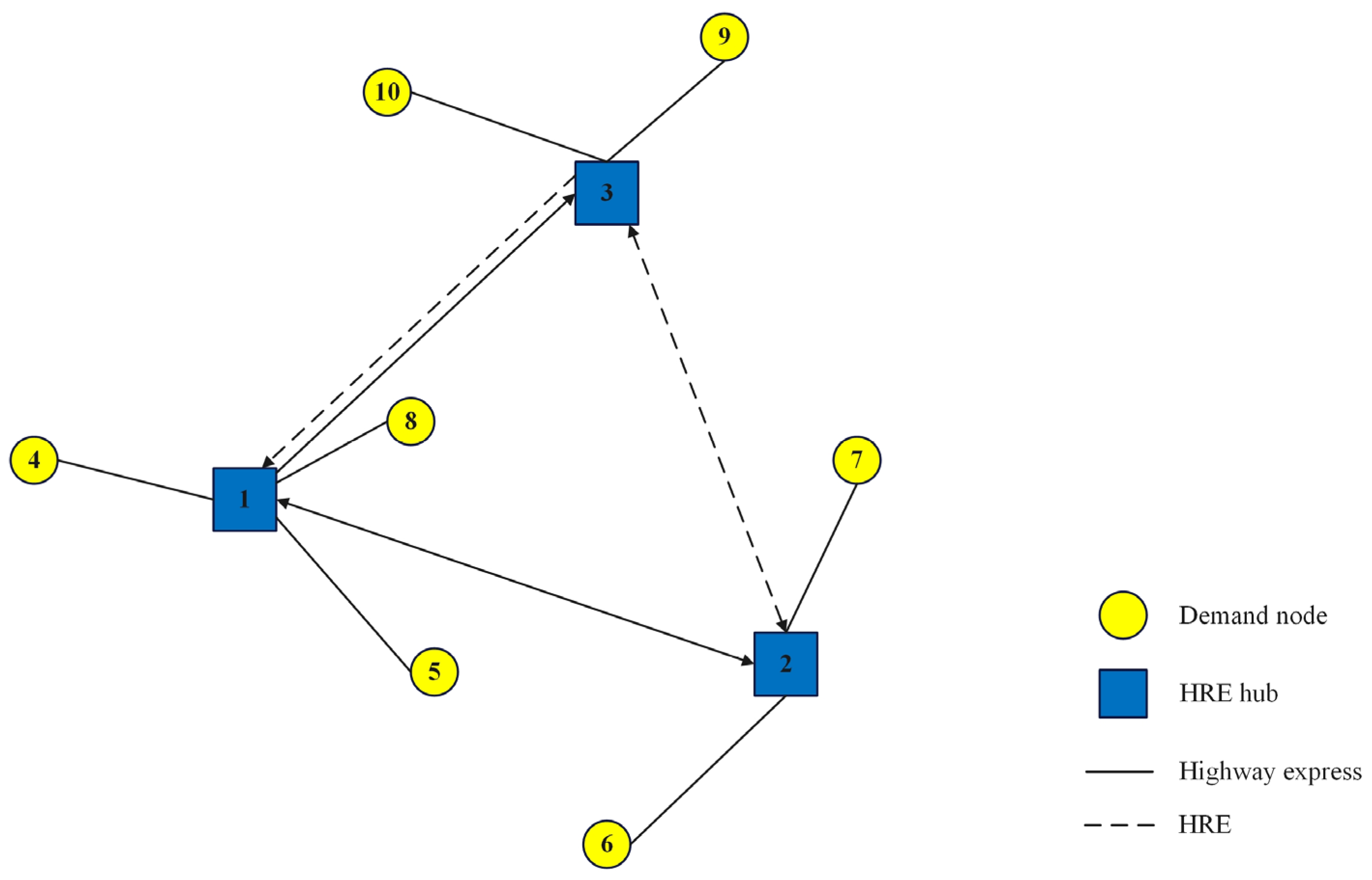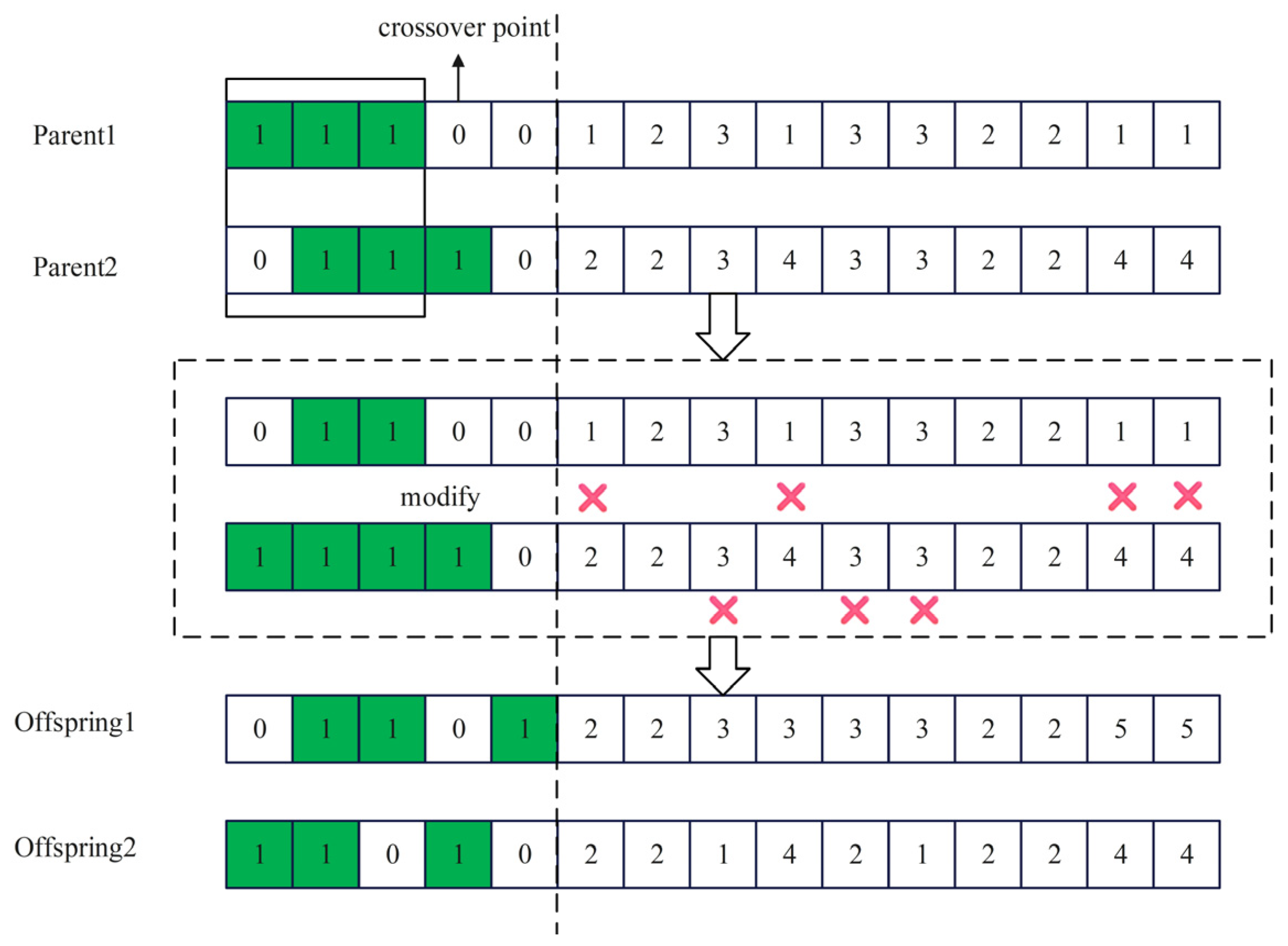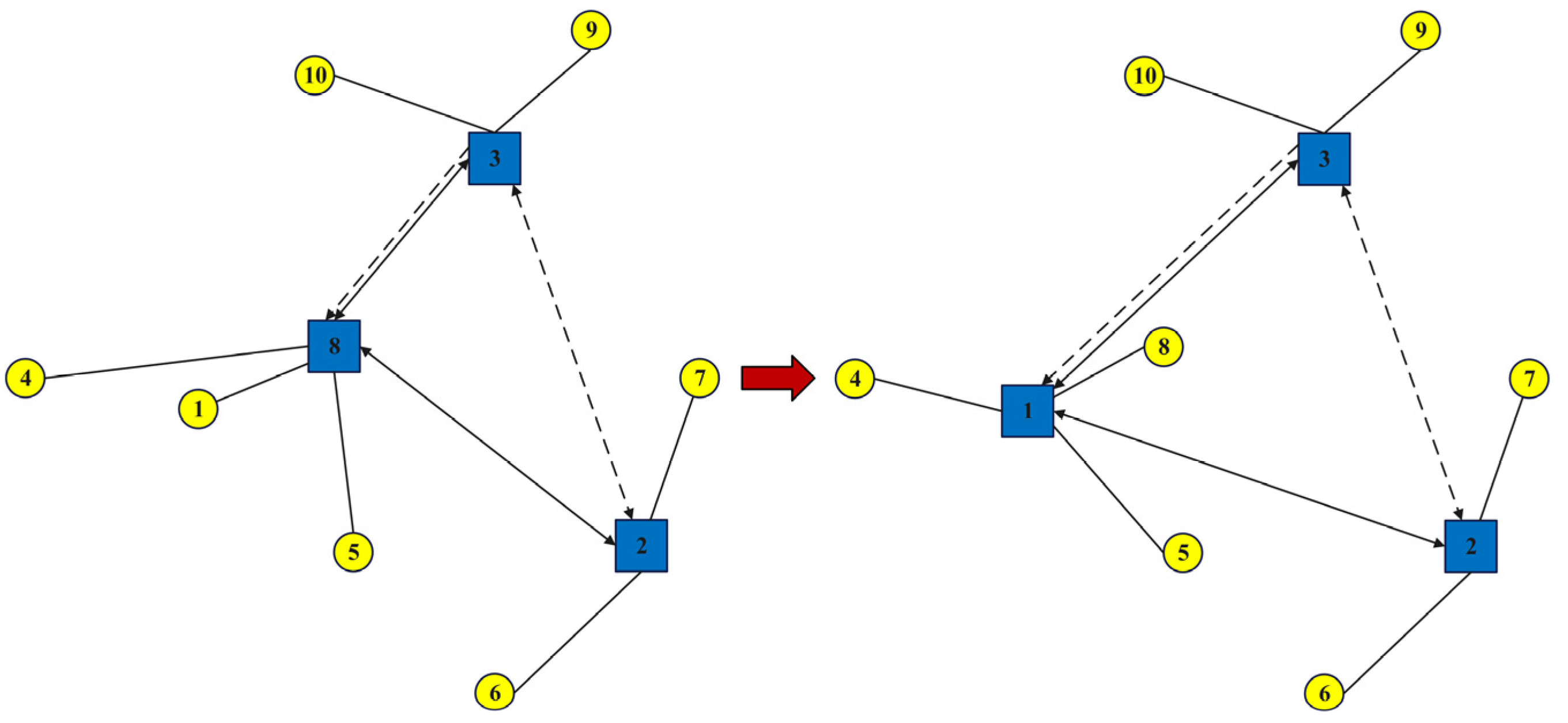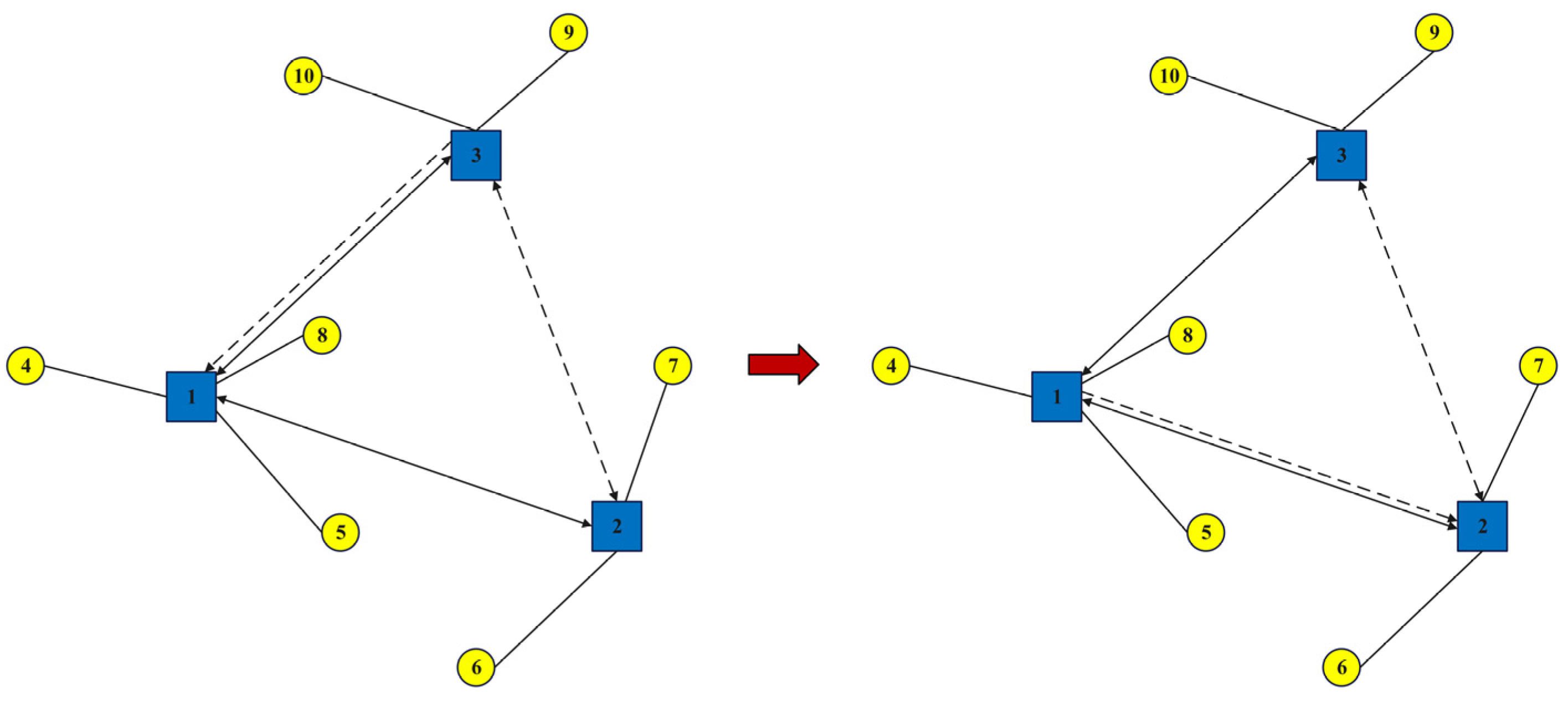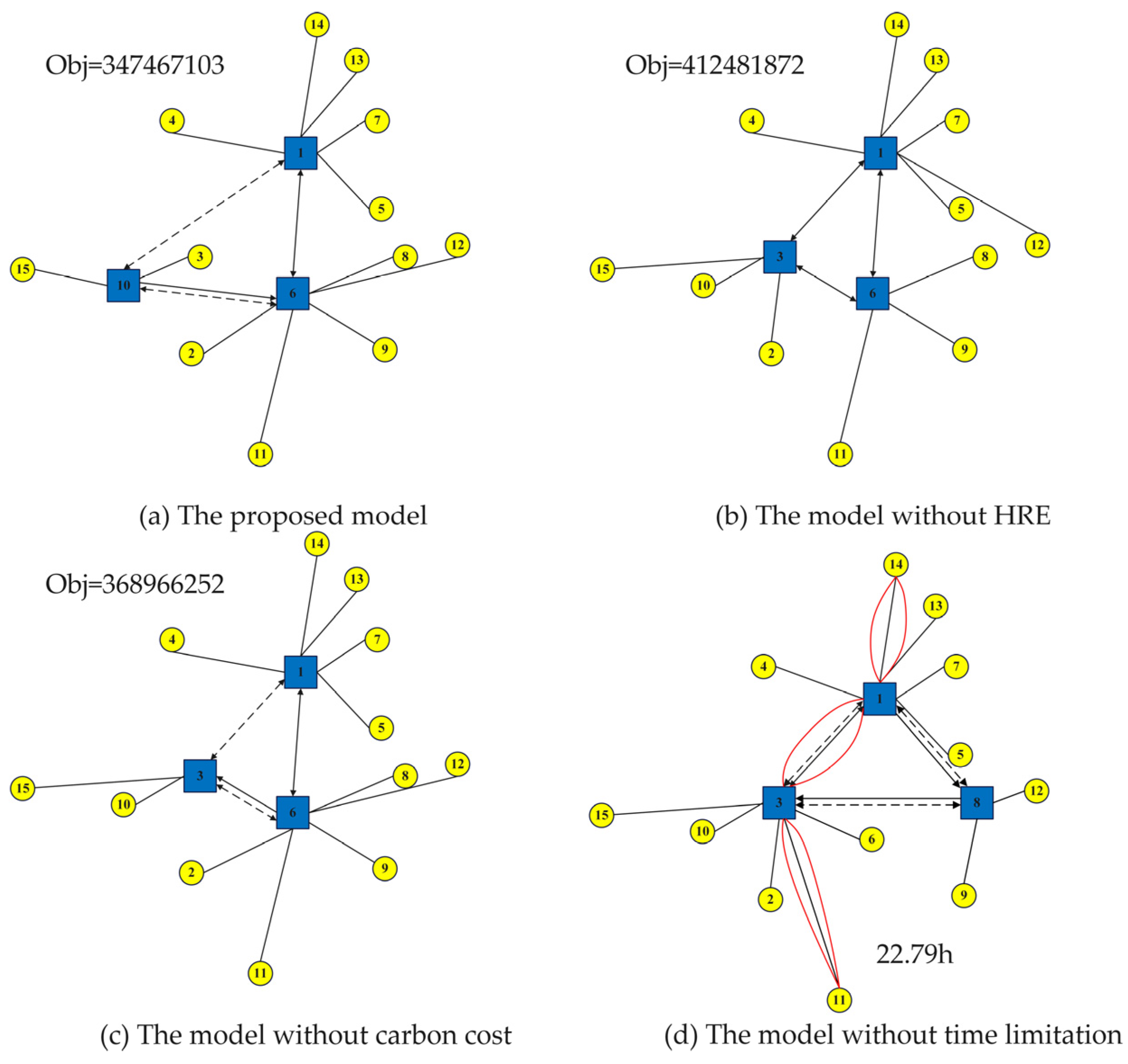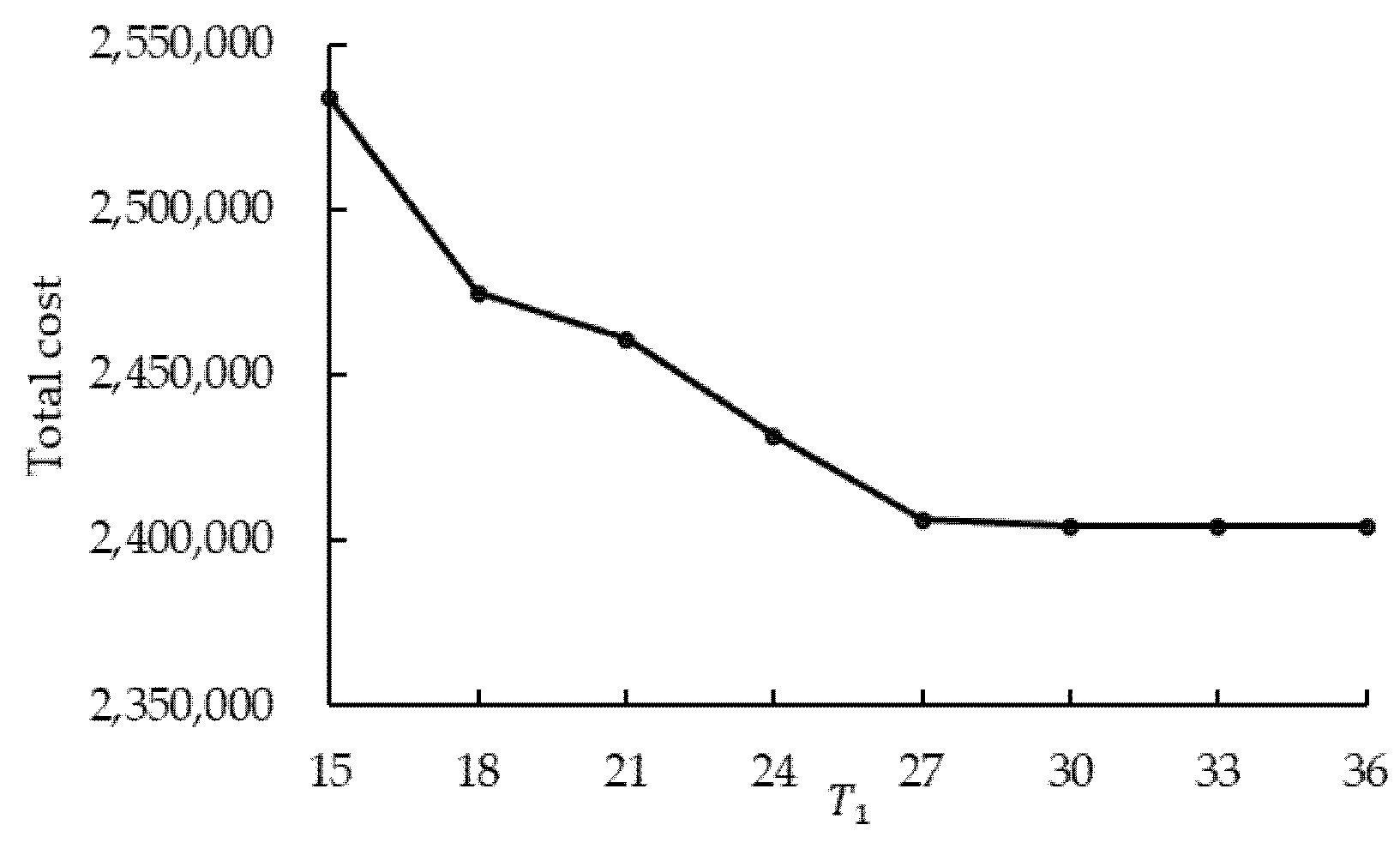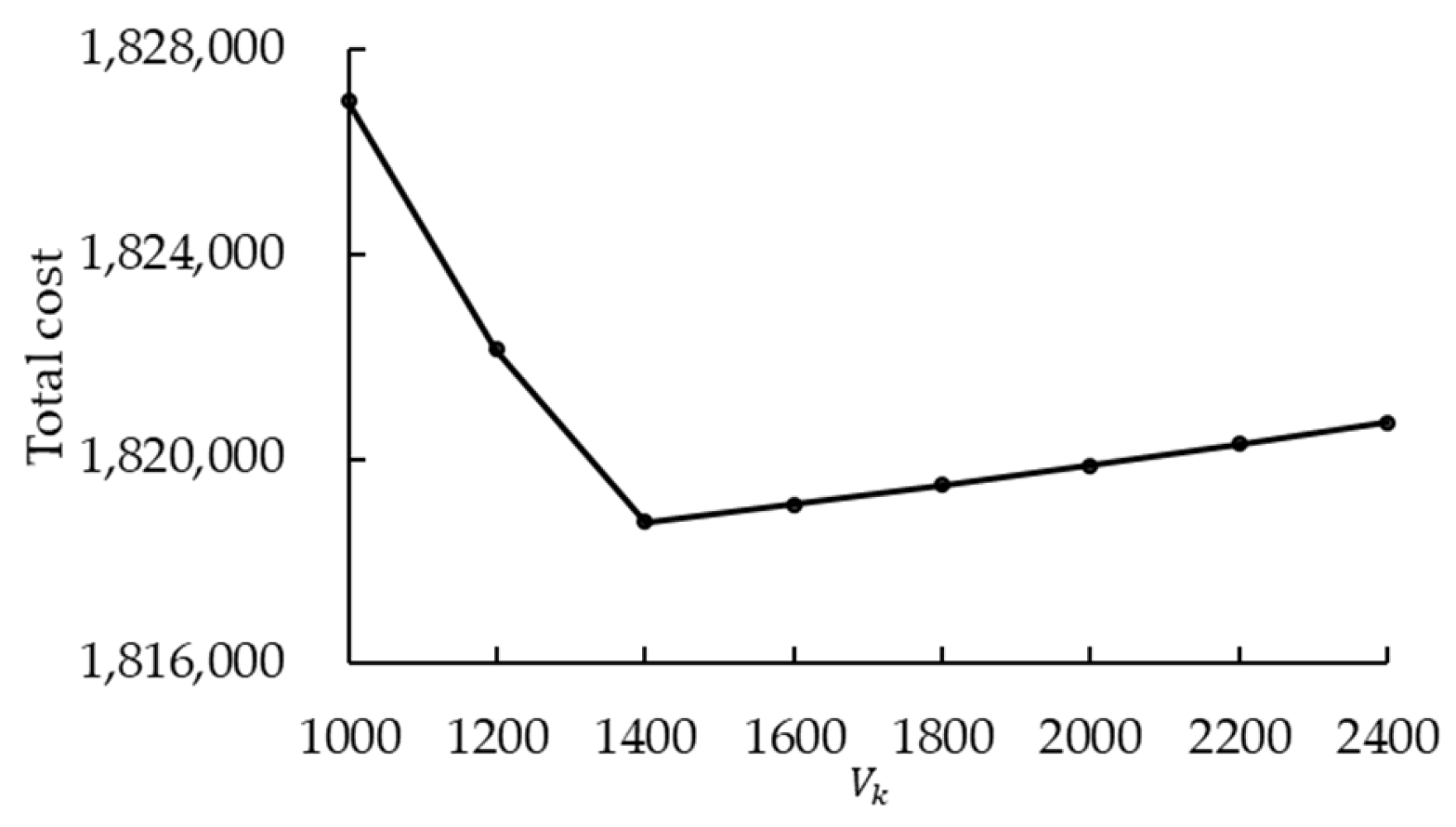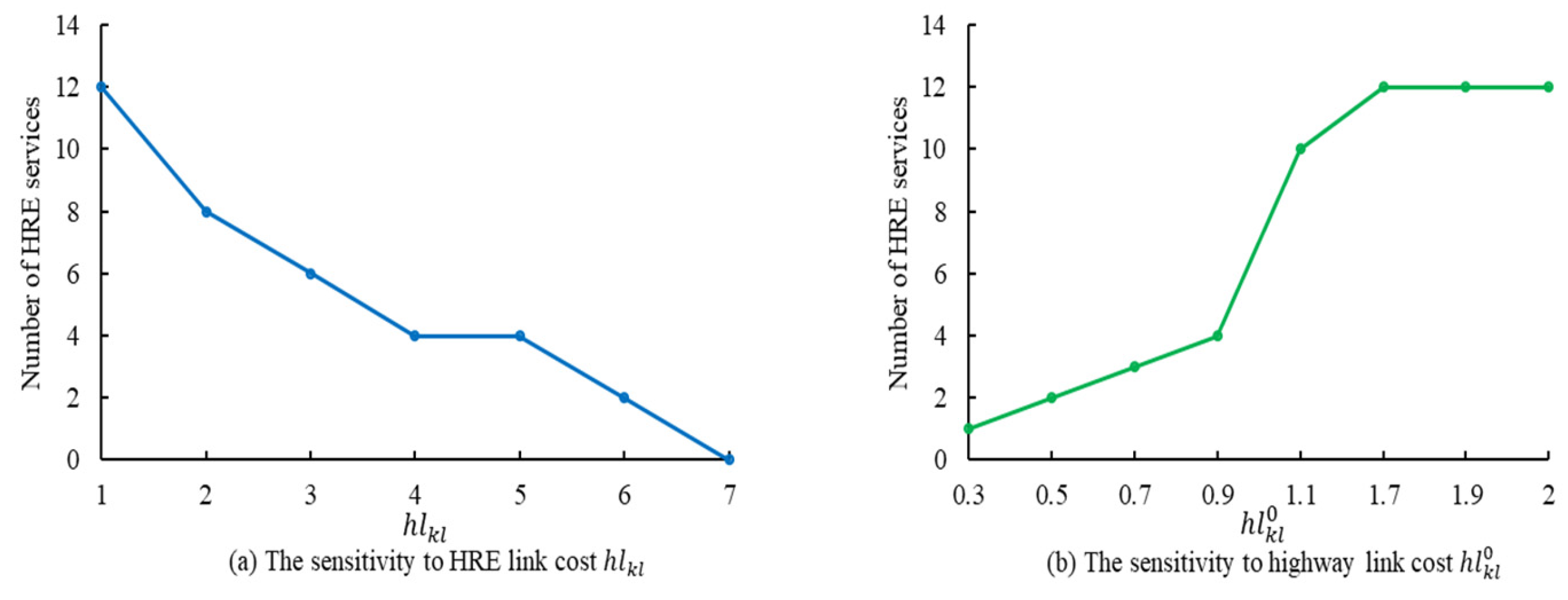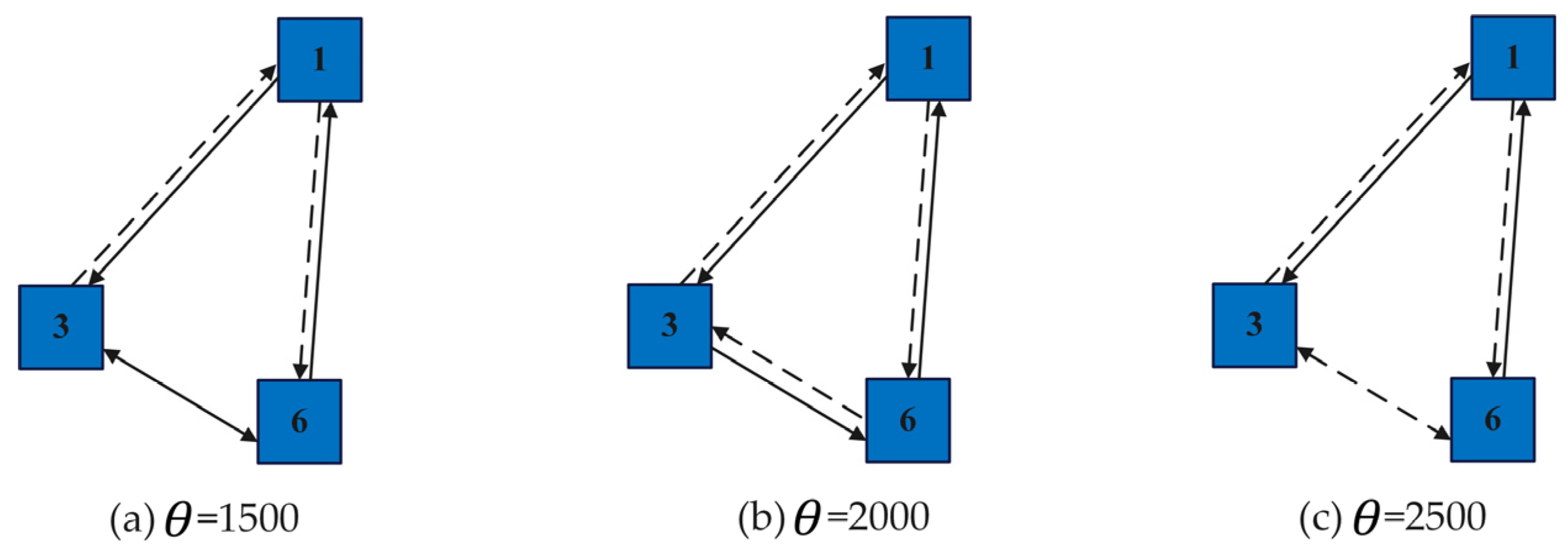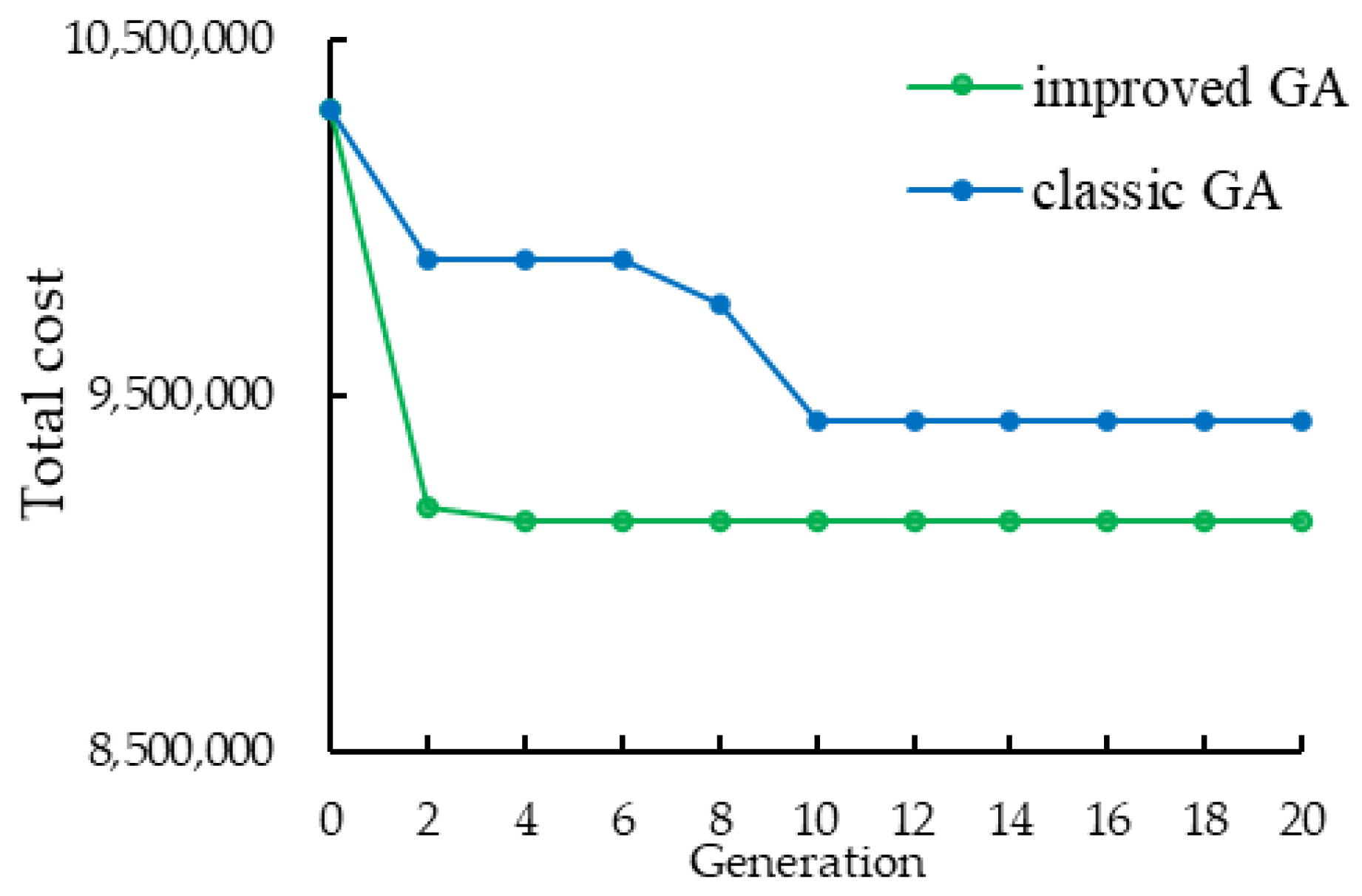1.1. Motivations
Recently, the rapid development of e-commerce and cold chain logistics has significantly driven the growth of freight transportation and express delivery demands. Additionally, the rising demand for transporting high-value freight, including business documents, medical supplies, and perishable goods, has imposed stricter requirements on delivery speed, environmental control, and transportation reliability. This dynamic has energized the freight express market while creating new operational challenges. As a new mode of freight transportation, high-speed railway express (HRE) has gained widespread attention. Compared to air freight systems, HRE demonstrates superior load capacity and operational reliability independent of adverse weather conditions; compared to highway transportation, HRE has faster speed and is not influenced by traffic congestion. In addition, HRE is powered by electricity, whose carbon emissions per unit are much lower than those of transportation powered by traditional energy sources. Owing to its advantages of low cost, high efficiency, and low carbon emissions, HRE has become an ideal choice in medium–long-distance logistics.
Although HRE excels in medium–long-distance transportation, its coverage is inherently constrained by fixed railway routes and hub locations. Highway transportation, conversely, offers unparalleled flexibility in last-mile delivery, remote area accessibility, and time-sensitive regional distribution. Compared to HRE, the most significant advantage of highway transportation is its door-to-door service. This complementary relationship necessitates an intermodal network in which high-speed railways handle trunk line transportation between major hubs, while highways manage feeder distribution and regional connectivity. Such an intermodal express network can not only increase the transportation efficiency, but also facilitate door-to-door service. It was reported that 1 percentage increment of the intermodal transportation volume in China can reduce the total social logistics cost by approximately 0.9 percentage points, saving about 100 billion yuan, meanwhile 1 percentage increment of the railway volume reduces overall logistics cost by 0.2 to 0.5 percentage points [
1]. This is the key motivation to study the intermodal express network of high-speed railway and highway transportation.
In the intermodal network, the critical challenge lies in the coordination of hub location and flow assignment, which are two complex and inter-related decisions. The integrated optimization of hub location and flow assignment is very meaningful for the intermodal express network. There are several key characteristics in the intermodal express network, mainly including transportation timeliness, hub and link capacities, and multiple transportation modes. Furthermore, the carbon emission is incorporated as a critical element into the modeling framework to evaluate the quality of the transportation. Therefore, this paper studies the intermodal express network of high-speed railway and highway transportation, and proposes an integrated optimization approach for the hub location and flow assignment problem to determine hub locations, demand node allocations, transport mode selections, and flow assignments.
1.2. Literature Review
The related literature will be reviewed in four main areas: the research of HRE, the hub location problem in the classical network, the hub location problem in the intermodal network, and the hub location and flow assignment problem in the intermodal network.
The research of HRE. With the development of high-speed railway networks, the research on HRE has grown significantly. Firstly, there has been a wave of research on the feasibility of HRE. Zhang and Qin [
2] analyzed the development of HRE from both technical and economic aspects, and finally concluded that it is feasible to carry out HRE in China. Boehm et al. [
3] investigated the development potential of HRE, revealing that replacing highway express with HRE could reduce carbon emissions by up to 80% and the operation cost can be mitigated by controlling the maximum speed of the high-speed railway. In addition, scholars have also proposed concrete strategies to support HRE development. Fang et al. [
4] developed a multi-criteria decision-making model to address the pricing strategy for HRE in competitive markets, which can increase HRE operators’ revenue by 13%. Based on the integrated demand forecasting, Huang et al. [
5] developed differentiated development strategies for HRE, concluding that the investment in high-demand areas should be prioritized and advocacy should be increased in low-demand areas. Recently, numerous studies on HRE have focused on its integration with other transportation modes. Wang et al. [
6] proposed an intermodal network of high-speed railway and crowd-couriers to enhance the operational efficiency and cost-effectiveness of freight service. Sun [
7] investigated the road–rail intermodal routing problem in a hub-and-spoke network and found that multiple time windows and truck operation optimization based on carbon cap-and-trade policies can reduce total costs and carbon emissions. Zhen et al. [
8] focused on the intermodal network of high-speed railway and highway transportation to optimize the vehicle arrangement, station selection, and route planning of HRE. In addition, there are also a few studies involving the organizational mode [
9] and scheduling optimization [
10,
11] of HRE.
The hub location problem in the classical network. Hub location constitutes a critical decision-making problem in both classical and intermodal networks. A review of classification, modeling, and solution methods for the hub location problem can be found in the existing literature, where the classical hub location problem can be divided into three categories:
-hub median problem,
-hub center problem, and hub covering problem [
12,
13,
14]. Racunica and Wynter [
15] analyzed the hub location problem for railway freight in a hub-and-spoke network and designed a heuristic algorithm to solve the problem. Gu et al. proposed a hub location model with multiple delivery time restrictions in the hub-and-spoke network [
16]. Aloullal et al. [
17] proposed a time-dependent hub location routing model, developing both exact and metaheuristic solution approaches to demonstrate how temporal decision-making improves adaptability to parameter changes. Wang et al. [
18] proposed a hierarchical single-assignment
-hub median problem to cope with multilevel demand. Marand and Hoseinpour [
19] focused on the congested hub location problem, aiming to optimize the total profit by determining the appropriate hub location and capacity.
The hub location problem in the intermodal network. O’kelly and Lao [
20] pioneered the idea of mode selection optimization in air–truck intermodal networks. Ishfaq and Sox [
21] extended the
-hub median model to intermodal networks. Alumur et al. [
22] proposed a single-allocation intermodal network optimization problem, considering the integration of land and air transport, and designed a heuristic algorithm for solving it. Boucher and Fransoo [
23] formulated a decision model to optimize terminal location and freight assignment across dedicated trucking transportation and intermodal networks, considering carbon emissions and mode transfer costs. Maiyar et al. [
24] proposed an intermodal grain transportation model in the presence of hub disruption while incorporating environmental factors for sustainability. Jeong and Choi [
25] introduced a multi-period capacitated hub location model to cope with the impacts of climate change and improve production sustainability. Ziar et al. [
26] proposed a railway–highway intermodal
-hub median model for the dry port location problem, establishing inland intermodal terminals connected to dry port. Somsai et al. [
27] focused on reducing energy consumption and emissions in intermodal networks by optimizing routes and using alternative transportation modes, proposing a general green vehicle routing model to identify optimal solutions for strategic decision-making.
The hub location and flow assignment problem in the intermodal network. Flow assignment is an important extension of the classic hub location problems. Serper and Alumur [
28] demonstrated that the use of alternative transportation modes and different kinds of vehicles to transport goods in intermodal networks can better deal with flow assignment and optimize the total cost. Song et al. [
29] focused on the transportation of hazardous goods and considered switching between railway, expressway, and ordinary transportation modes under traffic-constrained scenarios to optimize the freight services in the intermodal network of railways and trucks. Kovač et al. [
30] focused on the intermodal network of highway, railway, and inland waterway transportation to rationalize the assignment of container flows and contribute to the development of dry port terminals to promote the sustainability of intermodal networks. Hu et al. [
31] proposed a model for the intermodal network of an underground logistics system and highways to decide hub location, demand node allocation, and flow assignment.
To present the differences between this paper and the existing research more clearly,
Table 1 provides a brief summary of related references. The existing research involves some issues related to HRE, hub location, flow assignment, and intermodal network. To the best of our knowledge, there has been no research considering the hub location and flow assignment problem in the intermodal express network of high-speed railways and highways, especially taking the carbon emissions into account.
1.3. Research Contributions and Outline
The contributions of this paper are as follows:
(1) This paper develops an integrated model for the hub location and flow assignment problem in the intermodal express network of high-speed railway and highway transportation, considering the characteristics of multiple transportation modes, flow balance, carbon emission, capacity limitations, and time constraints.
(2) Due to the computational complexity of the developed model, an improved GA is designed by integrating genetic operators with two optimization strategies. The genetic operators are primarily used to enhance the solution diversity, while the optimization strategies aim to accelerate convergence.
(3) Numerical experiments validate the advantages of the developed model compared with degenerated models and demonstrate the effectiveness of the proposed algorithm in terms of time and accuracy. Additionally, several insightful findings are discussed.
The remainder of this paper is organized as follows.
Section 2 gives the problem description and model construction, and
Section 3 designs improved GA.
Section 4 gives the results of numerical experiments.
Section 5 discusses the managerial implications, and finally, the conclusions and future studies are presented in
Section 6.
